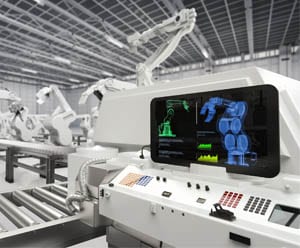
AI-powered IoT devices stand on the edge of change

The rise of generative artificial intelligence (AI) has transformed how we live and work, turbocharging creativity and productivity. AI bots, such as ChatGPT which became wildly popular in late 2021, have redefined the digital economy landscape.
But as Industry 4.0 – a new trend of automation and data exchange in manufacturing technologies – gears up, an even more powerful wave of AI is growing in importance.
Its backbone, edge computing, is an emerging technology that enables complex computations to be done closer to the data source. Edge AI, which is the implementation of AI algorithms in edge computing, helps to reduce latency. As a result, data can be processed much faster in an almost real-time fashion.
Edge AI can benefit a wide range of industries, from healthcare to manufacturing. But what truly sets it apart is its ability to accelerate data processing from the core to the edge of the network, underlining the importance of edge data centers.
Driving AI on the internet highway
The rapid development of AI has seen multiple industries deploying the technology in some form. From facial recognition to big data analysis, AI has transformed industry efficiency by offering dynamic solutions that tackle challenges in real-time.
Traditional AI services see data being fed back to the cloud for computations to be done. However, this could lead to latency issues and result in slower response time from devices.
Edge AI, on the other hand, can complete computations in the device itself. Internet of Things (IoT) devices that can benefit greatly from Edge AI include sensors that are used to compute footfall in a mall or to scan for traffic in driverless cars.
In the latter example, data can be processed in real-time on the car itself rather than relying on a centralized cloud. This enables faster and more accurate decision-making for improved traffic flow management.
In particular, the rise of IoT devices has made it more convenient for companies to use AI in sensors and smart devices to collect and analyze data quicker than ever before. By the end of 2032, there will be 34.4 billion connected to IoT devices worldwide, and many of them will be AI-enabled.
Giving the digital economy an edge
However, some edge AI applications that demand heavy computational power will still need to rely on the cloud.
As countries gear up for the transition to net-zero emissions by 2050, many governments have started relying on smart grids – electricity networks that depend on digital technologies like AI and heavy data processing to quickly analyze demand patterns to optimize electricity usage.
Smart grids produce incredible amounts of data that need to be constantly processed. The use of edge data centers – small data centers located close to the edge of a network – will become increasingly important to ensure low latency and almost instantaneous processing of a large amount of data.
Together, edge AI and edge data centers will form the key pillars of a digital economy.
Bringing healthcare closer to patients
In the healthcare industry, telemedicine – the act of consulting a doctor online – has greatly enhanced the ability of healthcare providers to care for an increased number of patients. This will significantly improve the quality of life for patients based in locations that lack easy access to high-speed internet.
IoT devices like wearable medical devices can be worn by patients to check their blood pressure, temperature, and heart rate – while the AI algorithm will process all this data for analysis by their doctors in real time.
With this, doctors are able to monitor their patients’ health even when they are not physically present. This then helps the patient better understand their health conditions and how to manage them.
Hospitals also utilize edge-AI models that process relevant patient data to help medical professionals assess risks better. Taipei Veteran General Hospital employs an edge-AI model that processes and analyzes patients' medical records and information to assess risk factors like cardiovascular disease in patients.
Medical professionals are also given access to an AI-powered dashboard that alerts and updates them on patients’ health in real-time. The hospital reports that implementing this model has allowed them to achieve an 80 percent lower chance of inaccurate diagnosis when patients are assessed for risks.
Edge AI’s vast potential
Edge AI is also enhancing manufacturing capabilities, with the rise of predictive analysis in the sector driving efficiency in Industry 4.0. As a result, companies can reap significant cost savings by avoiding downtime time in factories.
For instance, automotive manufacturer General Motors harnesses a computer vision system that allows employees to monitor the assembly process through images from cameras mounted on robots manning the production. This has helped the company save millions of dollars in downtime costs every year.
Therein lies the vast potential of edge AI, with industries constantly reaping the benefits for various scenarios. As AI looks to be deployed on a large scale across many industries, the role of edge AI-enabled devices will become increasingly critical as they look to serve a wide range of objectives.
ALSO WORTH READING













 English
English